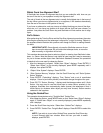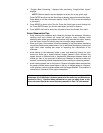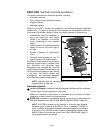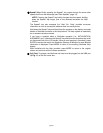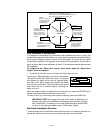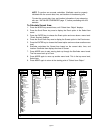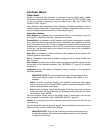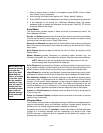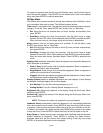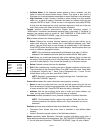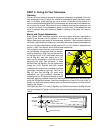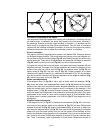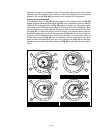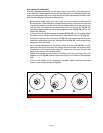
page 29
1. When a desired object is visible in the eyepiece, press MODE until the "Select
Item: Object" menu is displayed.
2. Scroll through the Object menu options until "Object: Identify" displays.
3. Press ENTER to search the database for the identity of the object being observed.
4. If the telescope is not directly on a Starfinder database object, the nearest
database object is located and displayed on the screen. Press GO TO and the
telescope slews to that object.
Event Menu
The Event menu provides access to dates and times of astronomical events. The
Event database includes:
Sunrise and Sunset calculates the time that the Sun rises or sets on the current date.
Find rise and set times for other dates (e.g., a date three months in the past or future)
by entering the new date into the "Setup: Date" menu.
Moonrise and Moonset calculates the time that the Moon rises or sets on the current
date. Find rise and set times for other dates by entering a new date into the "Setup:
Date" menu.
Moon Phases displays the date and time of the next Full, New, 1st Quarter, and 3rd
Quarter Moon.
Meteor Showers provides information on upcoming meteor showers (e.g., the
Perseids, the Leonids, etc.), the dates of the showers, and when they reach maximum.
NOTE: Meteors are fast moving objects that cover large areas of the sky
and are usually best observed with the naked eye.
Solar Eclipse lists upcoming Solar Eclipses, including the date and type (total, annu-
lar, or partial) of eclipse, and the location and time of the first and last contacts of the
Moon's shadow. Use the Scroll Up and Down keys to display the available data.
Lunar Eclipse lists upcoming Lunar Eclipses, including the date and type (total, partial,
penumbral) of eclipse. Use the Scroll Up and Down keys to display the available data.
Min. (Minimum) of Algol is the minimum brightness of the dramatic eclipsing binary
star system, Algol. It is relatively close at a distance of 100 light years. Every 2.8 days
during a 10-hour period, Algol undergoes a major change in apparent magnitude as
one of the two stars passes behind the other. The combined magnitude of the two
stars thus dips from +2.1 to a minimum of +3.4 halfway through the eclipse as the sec-
ond star is hidden. Starfinder calculates minimum magnitude time at mid-eclipse.
Autumn and Vernal Equinox calculates the time and date of the fall or spring equinox
of the current year.
Winter and Summer Solstice calculates the time and date of the winter or summer
solstice of the current year.
Glossary Menu
The Glossary menu provides an alphabetical listing of definitions and descriptions for
common astronomical terms and Starfinder functions. Access directly through the
Glossary menu or through hypertext words embedded in Starfinder.
A hypertext word is any word in [brackets], usually found when in the Starfinder Help
function or in a scrolling message such as a description of a planet or star. Press
ENTER whenever a hypertext word is displayed and Starfinder links directly to the
glossary entry for that word.
NEVER point the
telescope directly
at or near the
Sun at any time!
Observing the
Sun or an eclipse
of the Sun, even
for the smallest
fraction of a sec-
ond, will result in
instant and irre-
versible eye dam-
age, as well as
physical damage
to the telescope
itself.



